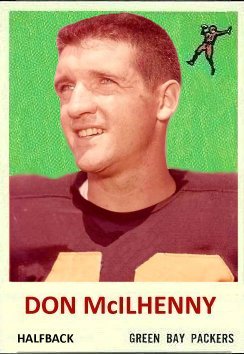38 men played for the Packers during their 1-10-1 1958 season. Adding Bob Skoronski and Ron Kramer who were in the military that season and veteran tackle Jerry Helluin who was injured, we have a 41-player nucleus that Vince Lombardi inherited in 1959. 16 of those players retired, were cut or traded before Lombardi’s first regular season game, leaving 25 returning veterans. 6’ 1” 195-pound halfback Don McIlhenny was one of the 26.
McIlhenny was born in Cleveland on November 22, 1934. The standard online reference tools like Pro Football Reference say that he graduated from South Houston High School, but numerous newspaper clippings indicate that Don instead went to Hillsboro High School in Nashville, Tennessee. In fact, McIlhenny was All-State as a senior in 1951 and was inducted to the Metro Nashville Public Schools Sports Hall of Fame in 2007.
Don starred in the backfield for Southern Methodist University, where he played with future pros Forrest Gregg, John Roach, Raymond Berry, Doyle Nix and Jerry Norton. He was drafted in the third round by the Lions in 1956 and spent one year in Detroit as a sometime starter who finished third on the team in rushing with 372 yards. Fellow rookie Jerry Reichow told the story to The Tennessean that quarterback Bobby Layne took McIlhenny, Reichow and Howard Cassady out drinking one night, but that Don was the first to fall, “McIlhenny obviously hadn’t been much of a drinker because [Layne] wiped him out early.”
The next season, McIlhenny was one of four Lions (along with linemen Norm Masters, Ollie Spencer and Jim Salsbury) traded to Green Bay for quarterback Tobin Rote and safety Val Joe Walker. Don had his best year in ’57 when he gained a team-best 384 yards on the ground, 362 on receptions and led the Pack with a 25.9 kick return average. Although his totals dipped in 1958, McIlhenny was praised in The Tennessean by coach Scooter McLean, “There are some backs who are faster and fancier than Don, but there aren’t any with more power and more desire.”
Lombardi made McIlhenny his starting right halfback in 1959, but by midseason, rookie flanker Boyd Dowler took Don’s place in the lineup. In the second Bears’ game, however, Paul Hornung had such a terrible game (four carries for -3 yards and three fumbles) that McIlhenny replaced him mid game. Don gained 54 yards on 11 carries and caught two passes for 27 yards in the 28-17 loss. McIlhenny told John Eisenberg for That First Season that Lombardi followed Don to the showers and told him that he played a “hell of a football game.”
That was McIlhenny’s last hurrah in Green Bay. In the coaches’ evaluations of the 1959 season that were later published in Launching the Glory Years, Don received middling praise. One coach said, “The best we have but we should try to get better ones.” Another coach added, “Good hard runner 100 percent boy. Can’t catch the ball very well. Fair blocker. We can use players like Don.”
McIlhenny was chosen by the Dallas Cowboys in the 1960 expansion draft along with Nate Borden and rookie Bill Butler. Thus, those three players got to experience the first head coaching season of both Lombardi and Tom Landry. Don later commented in The Tennessean, “Those two guys handled their first years completely different, but both did a terrific job.”
In the Cowboys’ inaugural season, McIlhenny appeared in 11 games and started seven. He finished second on the team with 321 yards rushing. The next year, Don was cut midseason and picked up by the 49ers to wrap up his pro football career. He later worked in insurance.
First custom card is colorized.





















